- HOME >
- Types of Tea
Producing tea from the White Tea Bush 2017
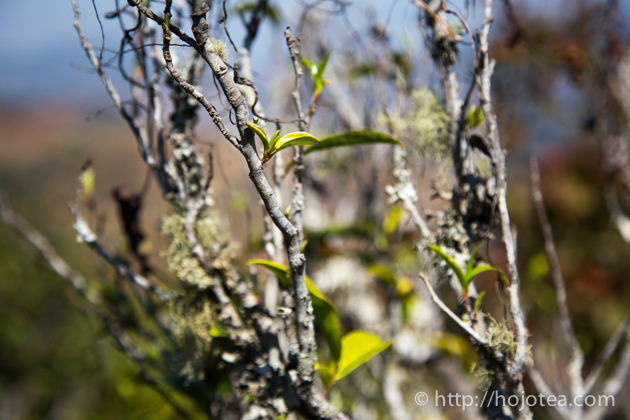
This year we are planning to produce Bai Shu Raw Pu-erh tea and Bai Shu Black Tea again. If we could manage to produce sufficient quantity of Bai Shu Raw Pu-erh tea, we plan to release the loose tea (mao-cha) on a pre-booking basis. We will then compress the remaining quantity into cake.
In Chinese, Bai Shu means White Bush. We refer Bai Shu as the tea tree grown naturally under the strong sunshine. The trunk of tea tree turns white due to the limited supply of nitrogen from the environment.
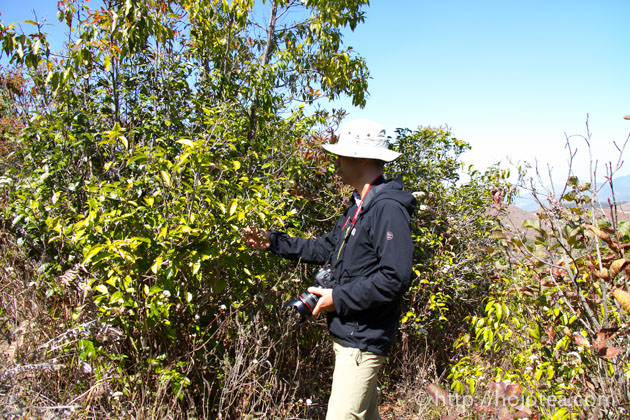

It looks like wild bush. Actually it is a naturally-farmed tea garden. As all plants co-exist, tea tree is one of nature plants and not the main player.
We visited the tea garden and confirmed the condition
In making Bai Shu tea, it is essential to find the tea garden or tea mountain which turning wild in nature. In recent year, a number of naturally-farmed tea garden is fertilized and the environment is changing. We are very concerned whether or not the natural environment remains the same as last year. So we went up to the mountain to confirm the condition of the tea garden. The tea garden is located in the west of Lincang and the altitude is around 2000m. 
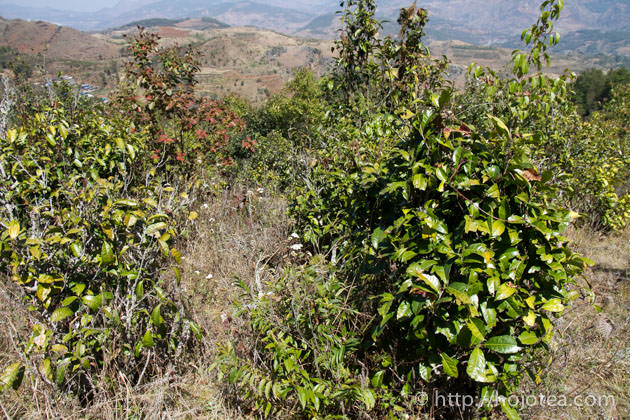
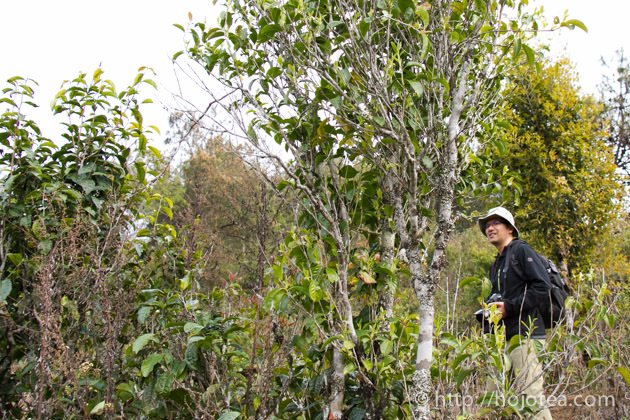
It looks like a dying tree
After checking the condition of the tea garden, I am very relieved. I observed that the tea garden remained natural and healthy. In fact, the tea garden is very messy and there are a lot of weeds. Tea trees are surrounded by many other plants. Some people may think that tea is dying because some branches are really dead. Perhaps if Japanese tea experts look at this situation, they may strongly recommend the use of fertilizers to “salvage” the tea trees.
Throughout my experiments, I came to aware that tea tree is controlling the number of branches and tea leaves according to the nitrogen intake. We often observe the same phenomenon in Japanese tea garden. Some branches of tea tree start dying when fertilizer is not sufficient. In the ecological environment, the tea tree is depending nitrogen on the surrounding ecology. Hence, tea may let dry some branches if less nitrogen is available, but it is nothing but the natural adjustment.


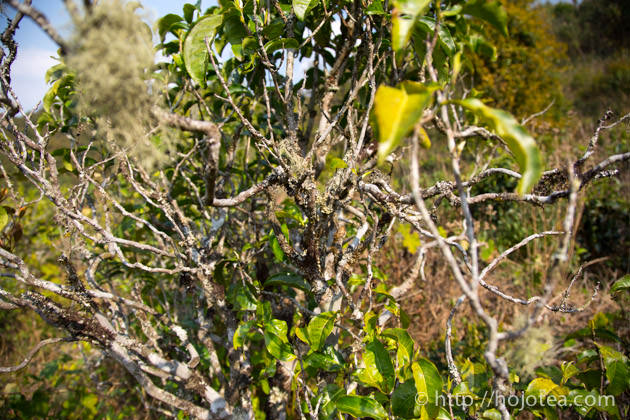
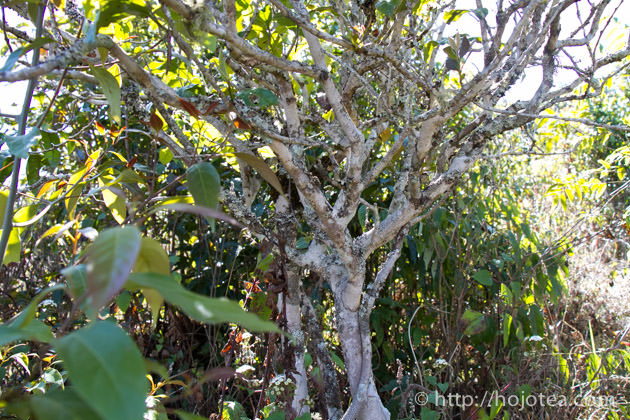
Fresh tealeaf reveals a lot of information
I believe many tea lovers have ever visited some tea gardens. If so, you may have experience of chewing the fresh tea leaf too. What was the taste of the fresh young tea leaf? Usually, at first it gives an astringent and bitter taste, and then followed by the fresh floral scent. In fact, this is the typical taste of tea grown in the fertilized tea garden. If we eat the fresh tea leaf of Bai Shu tea tree, it gives no astringency and no bitterness, and very intense floral scent that linger on our palate for a long time. It reminiscent the wild herbs we plucked in spring. The taste is clear, transparent and the aftertaste is very strong and long-lasting. The difference between fertilized tea and Bai Shu tea is like the different of farmed mushroom and wild mushroom.
The common tea garden in Yunnan
The following photos show tea garden in Yunnan. They use no chemical fertilizer but organic fertilizer is commonly used. The branches are very long, dark brown, and tea leaves in dark green. 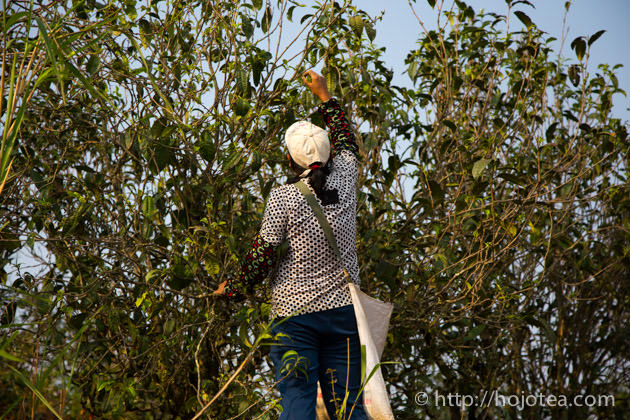

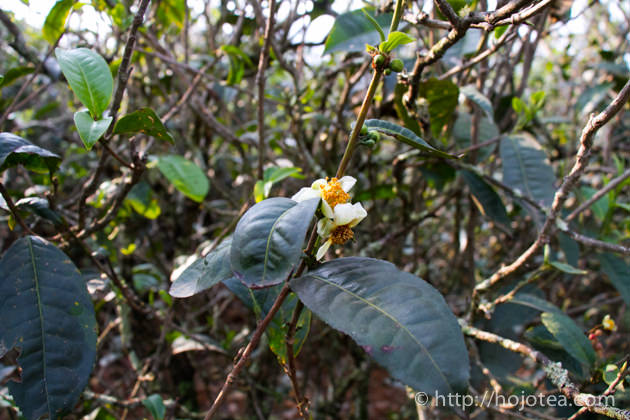
Tea plucking will start this week
Last year tea was sold out very quickly as we could not produce sufficient quantity. Since the weather seems very good in up-coming few days, I am hoping to speed up the collection of fresh leaves and we can produce as much tea as we are wishing.
Related Articles
How to get the latest update on HOJO?
1. Follow Twitter, 2. Click "Like" on Facebook, and 3. Subscribe in newsletter. You can have the latest tea news from HOJO.
 Subscribe the Newsletter to enjoy the privileges
Subscribe the Newsletter to enjoy the privileges- You may receive a free sample upon purchase, or you may have the priority to purchase special products. So please remember to subscribe our newsletter as well as the social network.
- Myanmar White Tea Bud 2013 from Guo Gan, Myanmar
- We have released a raw Pu-erh tea, 緬甸白芽茶 2013 (Myanmar White Tea Bud 2013), produced by ethnic minorities in t …
- Yong De Wild White Tea 2025 Loose Leaf Limited Release
- We have released Yong De Wild White Tea Loose 2025. For the 2025 harvest, only the loose-leaf type was …
NEW ARTICLES
 Myanmar White Tea Bud 2013 from Guo Gan, Myanmar
Myanmar White Tea Bud 2013 from Guo Gan, Myanmar- We have released a raw Pu-erh tea, 緬甸白芽茶 2013 (Myanmar White Tea Bud 2013), produced by ethnic minorities in t …
 Yong De Wild White Tea 2025 Loose Leaf Limited Release
Yong De Wild White Tea 2025 Loose Leaf Limited Release- We have released Yong De Wild White Tea Loose 2025. For the 2025 harvest, only the loose-leaf type was …
 Experience the True Freshness of Raw Pu-erh : Tang Jia 2025 Loose Leaf Release
Experience the True Freshness of Raw Pu-erh : Tang Jia 2025 Loose Leaf Release- We have released Tang Jia Raw Pu-erh Tea 唐家古樹生茶 2025 Loose Leaf. Among HOJO’s raw pu-erh teas, Tang Jia Raw Pu …
 Yunnan Chun Jian Green Tea from High Mountain Gardens
Yunnan Chun Jian Green Tea from High Mountain Gardens- Yunnan Chun Jian Green Tea is now available. This tea is made from naturally grown leaves harvested from high …
 Limited Loose Leaf Release of 2025 Da Xue Shan Wild Raw Pu-erh Tea
Limited Loose Leaf Release of 2025 Da Xue Shan Wild Raw Pu-erh Tea- We have released the 2025 loose-leaf version of Da Xue Shan Wild Raw Pu-erh Tea. This tea comes from wild tea …
 Discover a New Way to Enjoy Tea: Cooking Rice with Tea
Discover a New Way to Enjoy Tea: Cooking Rice with Tea- Cooking rice with tea is a simple idea, but it brings surprisingly satisfying results. The tea’s flavour seeps …
 2025 Da Xue Shan Wild White Tea Now Available from Yunnan
2025 Da Xue Shan Wild White Tea Now Available from Yunnan- The 2025 harvest of Da Xue Shan Wild White Tea is now available. Crafted from truly wild Camellia taliensis tr …
 Fresh 2025 Yunnan White Tea – Select Your Favourite Lot Before Blending
Fresh 2025 Yunnan White Tea – Select Your Favourite Lot Before Blending- Freshly crafted in Yunnan and just arrived in KL, our new 2025 white tea is now available at our Gardens Mall …
 2024 Dong Shan Raw Pu-erh Tea – Crafted with the Producer for Desired Quality
2024 Dong Shan Raw Pu-erh Tea – Crafted with the Producer for Desired Quality- We have released the 2024 cake of Dong Shan Raw Pu-erh Tea. Earlier, we offered the loose-leaf version from th …
 Development of Firewood Roasted Hojicha Using Naturally Grown Tea from Yunnan
Development of Firewood Roasted Hojicha Using Naturally Grown Tea from Yunnan- We are currently staying in Yunnan Province for tea production. As the season nears its end, tea trees with pa …
Category
- New Arrival at HOJO Online Shop
- Featured Articles
- Newsletter
- Types of Tea
- Origin of Tea
- Teapot and Tea Equipment
- Tea Column
- How to enjoy tea
- Tea Processing
- How to choose quality tea
- Tea constituents and functional effect
- Safety of Tea
- Foods
- Tea Business Operation
- Hobby and Outdoor Activity
- Ranking of Tea
- Video
- FAQ
- Media Release
Profile

- AKIRA HOJO
- I invite you to experience my tea selections.I was born in Nagano, Japan. In university, I studied agricultural chemistry, and I have the master degree in food science. I worked in Japanese food industry for 10 years. I involved in R&D, QC and QA. As a factory manager, I implemented ISO9000 series and managed the factory.
- The Art of Tea Magazine
- We posted the article on “The Art of Tea Magazine No.9, the magazine is published in Taiwan. We featured …
- New Straits Times
- The Malaysian National Newspaper, New Straits Times featured HOJO Tea on 17-Oct-2007.
Shop Info

Address:Lot No. T-215, 3rd Floor, The Gardens Mall, Mid Valley City, Lingkaran Syed Putra, 59200 Kuala Lumpur
Tel: +603-2287-4537
Business Hour: 10am to 10pm














